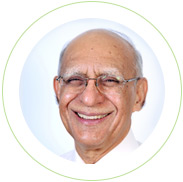Ashok Soota Co-Founded Happiest Minds with 11 Co-Founders. Prior to founding Happiest Minds in August 2011, Soota led the growth of Wipro’s IT business from $2Mn to $500Mn run-rate. Subsequently, he was founding Chairman & MD of MindTree and led it through a highly successful IPO. Soota was President of CII and also President of Manufacturers Association of Information Technology. He has served on Prime Minister’s Task Force for IT and on the Advisory Council for the World Intellectual Property Organization. He has been recognized twice as IT Man of the year and also as an Electronics Man of the year to name a few of the recognitions. Soota holds an engineering degree from Roorkee University (Now IIT Roorkee) and an MBA from Asian Institute of Management, Philippines. He is a fellow of INAE.
In-spite of this being one among the many of the 1000s of IT companies in India, he realized that change represents the opportunity and wanted to differentiate his offerings accordingly. When he started MindTree in 1999, he recollects that the change in the market was the Internet where 100s of companies started but 98 of them collapsed when dotcom bust occurred. Over a decade, there were many disruptive technology changes in the market but there was no new player who took everything and integrated the solutions while new small companies were doing cutting edge work but only in specific areas: e.g. a mobility company or an Analytics only company. He found a clear opportunity well ahead of the others and wanted Happiest Minds to provide this. He always believed in keeping his employees happy and he knows that happiest employees meant happiest customers and hence the name Happiest Minds.
In-spite of Happiest Minds being a startup, Soota decided to compete in the big league from Day 1. On the services mix, he got into SMAC because of his core team’s experience but went deeper than the surface level services offered by other large players and added disruptive technologies such as Unified Communications, iOT, M2M and made it a powerful combination – Digital Transformation, which is what Happiest Minds breathes. Soota structured the organization into 3 businesses – IMSS, Product Engineering and Digital Transformation & Engineering Services. These three businesses were supported by Global Practices as services for competence building and began providing strengths to each other. He also started a Hardware Design practices – eR&D, because lots of solutions needed some embedded capabilities to make them real time.
On his decision to focus on certain practices, Soota says that there were lots of Industry Data available which were provided by firms like Gartner, Forrester and Zinnov etc., that shows the way the market moves and also gives the market size and hence he did not put Research dollars into figuring out the market. This also gave him enough of data points on how he can get some sizeable share out of this growing market. He chose the focus areas based on those reports and applied the logic on where he can play well and got into the market and his hypothesis on the services were validated when the customers began coming in.
On creating an organization, Soota created an entity they wanted to become from the word GO and they had 8 sales offices in US and 8 others globally within the first year. Within 3 months they had hired 200 engineers and also invested in the CTOs office to develop IPs as they wanted to get 25% of their sales through their IP based solutions before they went public in the sixth or in the seventh year.
On Funding, Happiest Minds raised a Series A round of USD 52.5Mn from Canaan Partners and Intel Capital in addition to the founding team investing their own money. This largest funding, Soota says, created confidence in customers and convinced that they were there to stay and hence created a feeling of solidity and took a beautiful office to foster their own unique culture. They never got into SEZs with one big floor, but took small buildings and rapidly expanded with their own identity and cultures. They now have 3 buildings called Smiles1, Smiles2 and Smiles3 (SMILES is an acronym for Happiest Minds Values: Sharing, Mindful, Integrity, Learning, Excellence and Social Responsibility).
On the outreach to the prospective customers, Soota says that they had an attractive website with great content right from the start as he knew that everyone will look into their website once they hear about them. He also made sure that they got heard quite well in the market and appointed a great PR agency that did a mega launch. They also built a supply side, a people brand that had the most inclusive stock options. i.e., 24 Million stock options that were around 25% of the total equity making it one of the largest ESOPs in India. After creating their 16 sales offices within one year, they also created an Inside Sales team within 7 to 8 months as the outside sales guys need to be supported with leads. They leveraged the Social Media quite well and google on how they come up in search and within three years, they come up on Page 1 in many of the keyword searches which is remarkable for a young company.
The First Customer story was simple and timely. This was a person who had been a customer both for him as well as for his core team in several relationships in the past. It was coincidental that this person also left his job and relocated from Europe and went to the US at the same time when Happiest Minds was launched. He could have considered a few of the previous IT partners that he was working with in the past but chose Happiest Minds because he had the confidence in the new team and reached out to them. Soota also was happy to build on a past relationship. Soota says that this was almost too good to be true that they had signed up with this customer even before the formal launch. This may be called beginners luck, but Soota says that one also needs to make one’s own luck.
Soota had announced the company in April 2011, and the team came in and gradually began to join. He did not have people from Day 1 to help him process everything. On 29th August 2011, he launched with a press release and shortly after came his second customer – OneAssist. This was funded by Sequoia and the promoters heard about the launch. They were under a huge time pressure to build out a customer platform and they were also in advanced stages of negotiation with 3 or 4 leading product engineering players and 2 smaller niche ones. The Consultant who was hired to select a partner saw the press launch and immediately went to the website and was very interested in knowing more and came along with their CTO to Happiest Minds office. The dedicated team of three, Salil Godika – one of the Co-Founders (Marketing & the Industry Head), Sajith (Pre-Sales and Delivery Head), Srikanta (Indian Sales Head) were assigned to the account. The team did the initial meeting and then went to meet OneAssist top management team in Mumbai in-spite of the late stage of evaluation.
The initially scheduled one hour meeting went on for three hours and the team presented an approach to creating a platform which the customers liked. They had to then convince the customer that they not only know the technology, but also their domain expertise in the context of Finance linked with Travel and could value add to the customers solution. Even though it was a reputed team of founders, Happiest Minds still had to compete against very established organizations for the deal. They had to change their large company selling style of the past having strong and proven practices with delighted customers in the same industry to a startup selling style of the team having lots of past proven experiences but with no customers. The customer also saw the competent team coming out of cushy jobs and saw the enthusiasm to prove once more in the market and shortlisted them. They did a couple of more meetings in Mumbai and OneAssist came over to Bangalore for a due diligence. They were again pleased to meet the top management who stood committed to the engagement and were happy with the connect and the focus they will get as one of the first few customer as against being one more in the many customers of large and established players. The sales cycle was around 8 weeks and three years later, OneAssist is now a successful company and still a customer and the engagement grew from building the first version of the product and doing several upgrades to now supporting the product through their IMSS business.
Soota says that building one’s own IP is a huge value-add as that got him into a value adding role than just responding to RFPs. They always try to get annuity based income linked with a development of range of IP solutions delivered on SaaS. They also try to make the customers an Inter BU account and build practices based on customers’ needs where they enlarge their presence within the account and also give a good experience to the customer.
Soota had initially built engines of Delivery, GoToMarket and 3 SBU. He also created industry groups and now they are making them domain intensive Industry Groups. They began with Travel, Media & Entertainment, Retail (TIMER), BFSI and Manufacturing & CPG .They began investing more in Retail where they are developing Omni Channel solutions and an engagement platform as part of their IP
Soota’s advice to early stage startup founders – In the starting stages, there will be anxiety , but it will take two or three customers to get the confidence and one has to get them early enough. Customers are very happy to work with new players if they have confidence on the team. This is an experience based business and people are willing to experiment to experience a new team. Create a prototype when there are doubts and get a commitment because you are reducing the risk for the customer and develop the road map to grow their business. Any customer will have multiple partners and they might be thinking why they would need another one if you would go with generic offerings. Soota says that the best way to penetrate a new account will be to get into the Innovation Area where large players will not be willing to go after. Since these new practices require huge amount of investments and the larger competitors are under market pressures to get growth equivalent to creating a new mid-size company every year. Happiest Minds was always able to set up a small team for Innovation projects and demonstrate their capability within the stipulated time. The top 2 customers today including a Retailers in the US had the same objection and they used the innovation pitch to penetrate. The retail customer wanted to demonstrate something in an Apple show and mobile was one of the key interfaces and Happiest Minds took the challenge and completed the application within the stipulated time and the client’s solution received an award in the Apple show.
Everyone should focus on making customers successful and creating a win for them. Have an experienced team in place would give the investors and the customers a lot of confidence. In MindTree, funding was so easy that it came with a phone call but in Happiest Minds, the core teams’ capability helped bring in the funds. It took a few months with presentations to the Investment Committees of the VCs. The logic applies with the customers also where one needs to expose a seasoned team to be able to do what is committed. No customer wants to experiment with a team having no experience as it is their jobs that will be at stake.
Soota also says that it is important to leverage partnerships when you are a young company. The best situation is that the customer is keen on a product and the partner is willing to endorse you as a Systems Integrator and also point you towards the customer. If you bring your partner in to one of your relationships and open the door for them, they also will help you into their relationships and this can bring you good growth.
Soota also advises founders on not to get worried on pricing and undercut because you are a startup. If you become the discounted supplier, you get stuck and even getting a 10% increase later is tough. You have to be positioned as someone who is delivering value, provide value for money but on fair price and also advices not to do a Build Operate and Transfer as the objective is to develop a growth business.
Happiest Minds is about to finish the 3rd full financial year with a USD 50Mn run rate and has 94 customers and has around 1450 people. All these three are records for a 3-year Indian IT services company in India. They have also won multiple awards and to name a few, they been recognized by Inc India in the “Innovative 100 companies”. Deloitte has ranked Happiest Minds #13 in its prestigious Technology Fast 500 APAC and #2 in its Technology Fast 50 in India. Chestnut Global partners have rated Happiest Minds #5 Pan India for Employee Health and Wellness Rankings. Zinnov, a market expansion advisory firm has rated Happiest Minds in the “Niche & Emerging” Zone in the Global Engineering R&D Service Provider in 2014.






